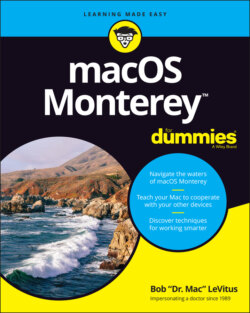Читать книгу macOS Monterey For Dummies - Bob LeVitus - Страница 37
Contextual (shortcut) menus: They’re sooo contextual!
ОглавлениеContextual menus (also called shortcut menus) list commands that apply only to the item that is currently selected. Contextual menus might be available in windows, on icons, and in most places on the desktop.
To see whether a contextual menu is available, either hold down the Control key and click — which you can call a Control-click to sound cool to your Mac friends — or, for those with two or more buttons on their mice, right-click. Finally, most Mac laptops (as well as the Magic Trackpad and the Magic Mouse) let you click the trackpad using two fingers to simulate a right-click or a Control-click.
If this doesn’t work for you, launch System Preferences and click the Trackpad icon. Click the Point & Click tab and make sure that Click with Two Fingers is selected as your Secondary Click and (of course), the Secondary Click check box is enabled.
Another reason the contextual menu might not appear is that it is available only if any of its commands make sense for the item that you Control-click or right-click. That’s why people call ’em contextual! They’re specific to the current context, which is whatever is selected or Control-clicked.
Figure 2-7, left, shows the contextual menu that appears when you Control-click (or right-click) a document icon. Figure 2-7, right, shows the contextual menu you see when you Control-click the desktop.
FIGURE 2-7: Only relevant items appear in a contextual menu.
Contextual menus are also available in most applications. Open your favorite app and try Control-clicking to find out whether those menus are there. In most cases, using a contextual menu is a quick way to avoid going to the menu bar to choose a command. In some programs — such as iMovie and Music — contextual menus are the only way to access some commands.
To make the Finder-related contextual menus available to users who didn’t have the foresight to purchase this book, Apple added the Action icon (shown in the margin) to the toolbar. As a result, people who don’t know about Control-clicking or right-clicking (or have only one free hand) can access most contextual menu commands by clicking the Action button and displaying its context-sensitive menu of shortcuts. You, on the other hand, gentle reader, know how to get at these commands without having to run your mouse all the way up to the Action icon in the toolbar. Plus, a handful of commands appear in the Control-click/right-click contextual menu but don’t appear in the Action icon/menu.
Get in the habit of Control-clicking (or right-clicking or two-finger clicking) items on your screen. Before you know it, using contextual menus will become second nature to you.
